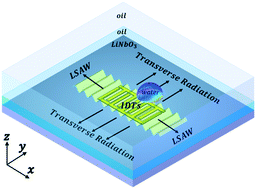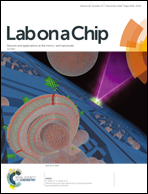Three-dimensional numerical simulation and experimental investigation of boundary-driven streaming in surface acoustic wave microfluidics†
Abstract
Acoustic streaming has been widely used in microfluidics to manipulate various micro−/nano-objects. In this work, acoustic streaming activated by interdigital transducers (IDT) immersed in highly viscous oil is studied numerically and experimentally. In particular, we developed a modeling strategy termed the “slip velocity method” that enables a 3D simulation of surface acoustic wave microfluidics in a large domain (4 × 4 × 2 mm3) and at a high frequency (23.9 MHz). The experimental and numerical results both show that on top of the oil, all the acoustic streamlines converge at two horizontal stagnation points above the two symmetric sides of the IDT. At these two stagnation points, water droplets floating on the oil can be trapped. Based on these characteristics of the acoustic streaming field, we designed a surface acoustic wave microfluidic device with an integrated IDT array fabricated on a 128° YX LiNbO3 substrate to perform programmable, contactless droplet manipulation. By activating IDTs accordingly, the water droplets on the oil can be moved to the corresponding traps. With its excellent capability for manipulating droplets in a highly programmable, controllable manner, our surface acoustic wave microfluidic devices are valuable for on-chip contactless sample handling and chemical reactions.



 Please wait while we load your content...
Please wait while we load your content...